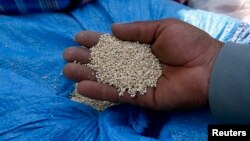Australia and the United States, two of the world's biggest wheat exporters, are racing to become mass producers of the South American “superfood” quinoa and tap a gluten-free market expected to be worth more than $6 billion by 2018.
Importantly for Australian wheat farmers who regularly battle crop-destroying droughts, the nutritious grain-like seed pronounced 'kin wa' can handle extreme climates.
It also sells for around $3,000 a ton, compared with wheat which fetches under $300 a ton.
“We have been growing quinoa for about five years now, and as the market has grown, there is little shortage of other farmers willing to turn to quinoa,” said Ashley Wiese, a farmer in Narrogin, southeast of Perth in Western Australia state.
Quinoa, the staple of Andean farmers for thousands of years, has taken health-conscious Western nations by storm.
Demand grew 300 percent between 2007 and 2012, data from the U.N. Food and Agriculture Organization shows, as traditional suppliers Bolivia, Peru, Chile and Ecuador struggle to meet demand from health-conscious Western consumers.
Quinoa prices doubled from 2007 to 2009 and rose almost unchecked until a peak in 2014, according to U.N. data. Demand for the nut-flavored quinoa shows little sign of easing.
The size of the global gluten free market is forecast to grow at 10 percent a year to be worth more than $6.2 billion by 2018, according to a 2013 report by Research and Markets.
Quinoa's attraction is that it is high in protein, gluten-free, and is the only food crop that contains all the essential amino acids, trace elements and vitamins.
Right seeds key to mass production
Developing the right seeds and farming techniques to mass produce quinoa, which is traditionally grown on small-acre farms in the Andes mountains, is the key to entering a market where global demand is outstripping traditional supply.
Australian scientists say they are less than three years away from developing a quinoa for the nation's hot, dry climate.
“Without appropriate yields, it is not commercially viable, but it has to have good quality that markets expect as well, so selection for a variety takes time,” said Dr John de Majnik, senior program manager at Rural Industries Research & Development Corporation.
U.S. farmers have been producing quinoa since the 1980s, but mass production still eludes them.
White Mountain Farm in the southern Colorado Rocky Mountains is one of the biggest producers, taking advantage of the high altitude which is the traditional quinoa climate.
“I estimate we are four to five years away from developing varieties adapted to different regions of the U.S.,” said Kevin Murphy, assistant professor of plant breeding at Washington State University and an expert on quinoa.
“The innovative and more risk-taking farmers who have experimented with quinoa have typically found the learning curve to be a bit steep, but the results are getting much better.”
New world quinoa a threat
In preparation for the eventual large-scale production of quinoa, Bolivia is seeking to establish a genetically unique brand "Quinoa Real" which will sell at a premium.
“Plans in Australia and the U.S. are going to mean a greater supply of quinoa...,” said Gary Rodriguez, general manager of the Bolivian Institute of External Trade, a private body that groups Bolivia's main agricultural sectors.
“There's more aggression from a business standpoint...in the dozens of countries that are trying to start producing quinoa. We know that there are at least 50 countries that are already trying to produce quinoa commercially.”
Australia's sea-level quinoa
Farmers from Australia's red dirt northwest to its southern island state of Tasmania are experimenting with quinoa.
In Sydney, the McDonald's food chain has put quinoa on its menu in “The Corner” cafe in Sydney, its new-look McCafe which seeks to tap the booming health food market.
But one of the big hurdles for Australian farmers is that quinoa is grown at altitude in summer, so in the absence of mountains, they are attempting to grow quinoa at sea level in winter.
“We have had good successes and some big failures. One of the things that we have been struggling to get our head round is just how big the crop is going to be,” said the farmer Wiese.
But for now the threat from “New World” quinoa is still a long way off for Candy Condori, a quinoa farmer in the southern Andean region of Puno in Peru.
“Quinoa has always been grown here, since the time of our ancestors, and it will always grow,” she said.
However, she and her neighbors know the world is hungry for their ancient food, so they plan to start using modern farm equipment like a motorized thresher to boost production, while certifying their quinoa as organic to fetch better prices.





